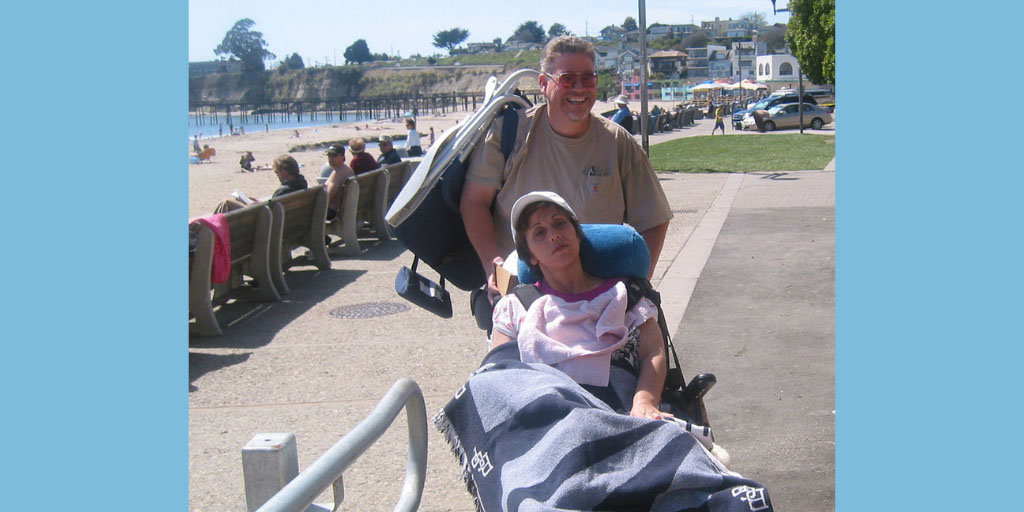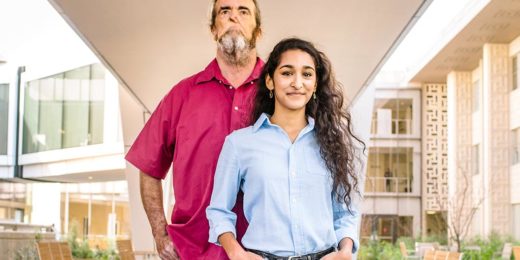As a first year medical student browsing through electives, the Walk With Me course caught my eye because it would pair me with a patient or family caregiver for a year to learn about their health care journey.
I went in thinking the course could help me develop empathy, learn about the emotional and social experiences that patients encounter, and better understand and relate to these difficulties.
While learning those skills is important for practicing medicine, I found out that isn't the whole story. My caregiver partner, Scott McLaggan, taught me that embracing what patients and their families bring to the conversation can improve health care for everyone.
Scott's life has been shaped by illness, but he is not a passive "victim" of it. Instead, Scott, a longtime caregiver for his wife, Tina, is constantly thinking about, implementing and experimenting with creative strategies to better care for her.
Becoming an advocate
In the 20 years since Tina had a stroke, Scott has become a strong advocate for improving long-term care for patients and their families. In his role as a volunteer for Stanford Health Care's Patient & Family Advisory Council in neuroscience, he has also helped counsel and comfort many caregivers like him.
I started Walk With Me in the fall of 2019. The pairing between students and their partners continues for a year, but I've stayed in touch with Scott. During the course time, Scott and I met on campus monthly, right after he finished his volunteer shifts at the neurology unit.
But for one of our meetings, Scott drove me to the couple's San Jose home to meet Tina. Along the drive, he talked about his health care experiences at Veterans Administration clinics and at Stanford Health Care. He talked about what policy changes are needed to care for our aging population. And, while driving through one suburban neighborhood, he challenged me to identify sub-acute long-term care centers in the area, noting the proliferation of those facilities and explaining the services they provide.
In their home, Scott showed me modifications that were made to aid in Tina's care and comfort. They include ramps for wheelchairs and motorized ceiling tracks to help move her around the home. He showed me a feeding tube that includes a mortar and pestle used to grind Tina's medications. In a big binder, Scott keeps hourly notes on her care, and documents the medications she's given and whether she's had any adverse events.
Finding what works best
When I asked Scott how he learned so much about caregiving and health care systems, he said that when his wife was discharged after her stroke, he was very lost. He learned strategies he needed from observing long-term care facilities, from talking with other caregivers, and from experimenting to find what worked best for Tina.
Caregivers, Scott said, are uniquely positioned to help others who care for loved ones. He described an experience counseling a man who was just embarking on the caregiving journey after his wife was diagnosed with cancer. Among the things he recommended was that the couple use a feeding tube when she reached the point of having no appetite or being unable to keep food down.
Not getting enough nutrition can greatly contribute to a decline in health, Scott told me. The woman's doctors counseled the couple about a feeding tube but they weren't receptive at the time. Scott speculated that doctors use numbers and statistics to make their point, which might not register with patients in emotionally laden situations.
Because of his own experience, Scott said he understood the couple's worries and questions, and could address them in concrete ways. He got them started by telling them which store has the right supplies, as well as how much feeding solution to get and where to get it. He also showed them on how to use the feeding tube.
His counsel assured the couple that managing a feeding tube was doable and would make a huge difference in her condition. When it came time for her to need it, they took his advice, and using a feeding tube helped her push through and eventually get better.
Scott continually impresses me with his knowledge about health care systems and caregiving. But my main takeaway from my time with Scott is that patients and their caregivers know things physicians don't, and do things physicians aren't trained to do. It's important to empower them and incorporate them into the conversation.
Marcello Kendrew Chang is a second-year medical student at the Stanford School of Medicine.
Photo, courtesy of Scott McLaggan, of him and his wife, Tina, on an outing in Capitola, California.






